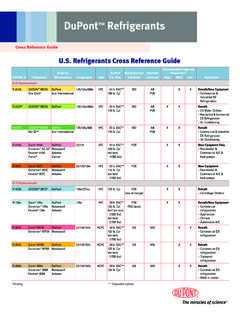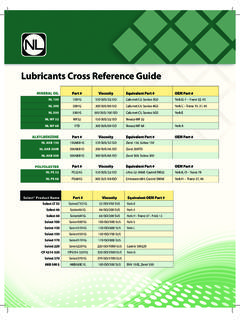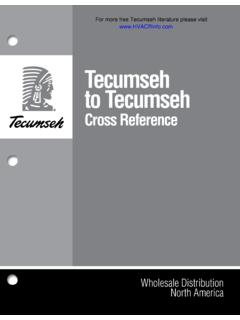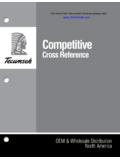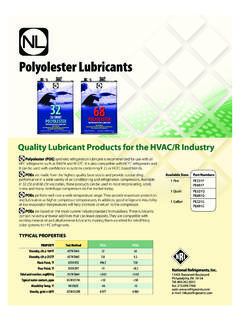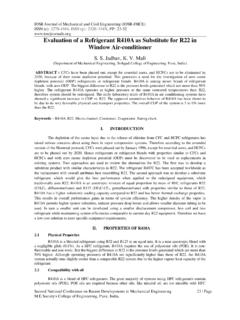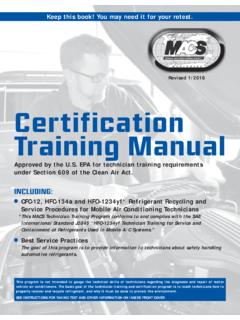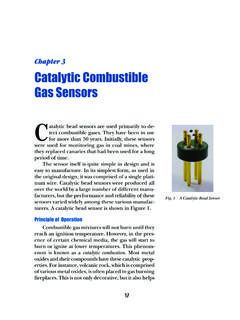Transcription of AMMONIA REFRIGERATION SAFETY MANAGEMENT - …
1 AMMONIA REFRIGERATION SAFETY MANAGEMENT . Mark Roxburgh Mercury Technologies Ltd., Hopps Cottage, Front Street, Hart, United Kingdom, TS27 3AJ. Phone: +44 (0)1429 867 000; e-mail: 1. ABSTRACT. AMMONIA as a refrigerant is an obvious choice in these times of ecological awareness. It is a natural substance and its thermodynamic properties are superior to many of the man-made alternatives. However, its hazardous nature must not be overlooked. End-users are legally and morally obliged to ensure that they have in place SAFETY MANAGEMENT sufficient to mitigate the risk associated with their AMMONIA REFRIGERATION systems. The programme described herein outlines a number of SAFETY MANAGEMENT tools that will allow the risk level to be reduced to as low as is reasonably practical.
2 2. INTRODUCTION. In advocating the use of natural refrigerants, we, as responsible designers, installers and end-users are quite rightly making a stand for the environment. One of these refrigerants, AMMONIA , is indeed a more ecologically sound alternative to the man-made fluids that have become in-vogue over the past 30 to 40 years. Its favourable specific and latent capacities and its efficient specific energy of compression have been recognised for many years. These positive aspects come, however, at a price. AMMONIA is a hazardous substance. Hence as before, we, as responsible designers, installers and end-users, must advocate the safe use of the refrigerant. We must ensure that our employees, our clients and the surrounding population are protected from the potentially harmful effects of AMMONIA .
3 Each country has its rules and regulations regarding health and SAFETY in the workplace and in everyday life. These rules address for example the need for risk assessment, for certain procedures to be followed regarding incident investigation and reporting and possibly training. The EU has certain overarching directives that deal with these and other issues in a more general way, including the ATEX and PED directives. Indeed, these two give quite specific instructions regarding the safe installation, operation and maintenance of plant. National and international codes and standards such as EN 378 give a great deal of further guidance regarding how to safely design, install and operate systems. Finally, national and international professional bodies provide various codes of practice and papers dealing with safe operating practices.
4 It is difficult for an operator to be certain that he or she is meeting all the requirements of these diverse codes and standards, especially since those responsible for health and SAFETY in some plants may not be familiar with AMMONIA : in fact they may not be technical persons at all. 3. THE PROGRAMME. In the United States, some 20 years ago, the US government's national SAFETY body OSHA. (Occupational SAFETY and Health Administration) issued a declaration requiring all users of hazardous materials to put in place a SAFETY MANAGEMENT programme aimed at mitigating the risk to health and SAFETY associated with that substance. They allowed the various industries to develop their own plans, which OSHA subsequently approved and monitored.
5 The American Society of Heating, REFRIGERATION and Air conditioning Engineers (ASHRAE, based in Atlanta, GA) and the International Institute of AMMONIA REFRIGERATION (IIAR, based in Washington DC) were charged with developing a plan for the AMMONIA REFRIGERATION industry. The plan was implemented in the late eighties and its use has been mandatory since then for all US facilities with more than 5 Tonnes of AMMONIA on site. Hopps Cottage, Front Street, Hart, TS27 3AJ, England Telephone +44 (0)1429 867000 e-mail We in Europe and the rest of the world do not have similar legislation. We have, as discussed earlier, a fragmented version, with guidance and requirements scattered throughout multiple national and international codes and standards.
6 We at Mercury Technologies have taken the broad, comprehensive model developed in the US and adapted it for use in other countries. The methodology was retained as was much of the content, but since, for example, EN 378 differs technically from the various US, AHRAE and IIAR standards, some modifications had to be made. The result is a SAFETY MANAGEMENT programme suitable for application, with some minor adjustments, in any EU country. The programme comprises the following elements Documentation Mechanical integrity of major hardware Mechanical integrity of peripheral hardware and systems Offsite consequence analysis Operating procedures Training Permits to work Contractor control Employee participation Incident investigation MANAGEMENT tree MANAGEMENT of change Pre-commissioning review Emergency response Annual review Hazard analysis Assuming the designer, installer, maintenance contractor and the end-user are all relatively competent, professional people, it is highly likely that most of the items on this list are already in place and meeting all requirements.
7 It is, however, incumbent upon us all, as discussed earlier, as responsible professionals to ensure that ALL items on the list are in order. Documentation From design, through purchasing, installation and commissioning to day-to-day operation, there must be a paper trail. A user must have AMMONIA charging records, pressure test certificates and drawings to hand. He must ensure that maintenance records are kept, that oil usage is monitored and that inspection authority and insurance certification is up to date. The need for this documentation is not simply to meet legislation. The data is required for maintenance, training and cost projections Mechanical integrity of major hardware Perhaps the most obvious element of the programme is mechanical integrity.
8 The hardware must be designed, specified, installed, commissioned, operated and maintained safely. A. detailed inspection of the system by a competent engineer will most likely identify inconsistencies. Each item of equipment and each significant piping system should be surveyed in detail. All nameplate information should be cross-reference with the original design documents as should the operating conditions. Pressure relief and/or protection should be checked. Accessibility, marking and labelling, protection from collision, suitability of supports, ease of maintenance and oil draining; all these issues should be looked into. IIR International Conference, AMMONIA REFRIGERATION Technology, Ohrid, Macedonia, 2009. An overall plant maintenance programme should be developed.
9 The various codes and standards available to us all, along with the manufacturers recommendations can be used to build-up a schedule that shows maintenance tasks ranging from daily checks, through weekly, monthly services up to annual shutdowns and less frequent rebuilds etc. The maintenance programme must include not only the major hardware components, but also the ventilation/detection /alarm systems and the personal protective equipment (breathing apparatus, showers, emergency lighting etc). Corroded pipe Mechanical integrity of peripheral hardware and systems There are SAFETY systems and equipment that, although not AMMONIA -containing, are paramount to the safe operation of the plant, especially during emergencies. Just as with the main hardware, these items must be installed, operated and maintained correctly.
10 A SAFETY MANAGEMENT programme such as the one outlined herein must pay due regard to these items. They are made detailed reference to in all relevant codes and standards and include: AMMONIA detection Ventilation Relief valves and associated vent piping Emergency lighting Eyewash / shower PPE, Eye wash & showers Signage A thorough survey of all these items should be carried out and shortfalls must be put right. Many of these systems must be covered by the preventive maintenance programme: kilometer Offsite consequence analysis 1. If there is a suspicion that an AMMONIA release may have reach beyond the 0. boundaries of the facility, those consequences should be investigated and quantified, where possible. Only by knowing 0.
